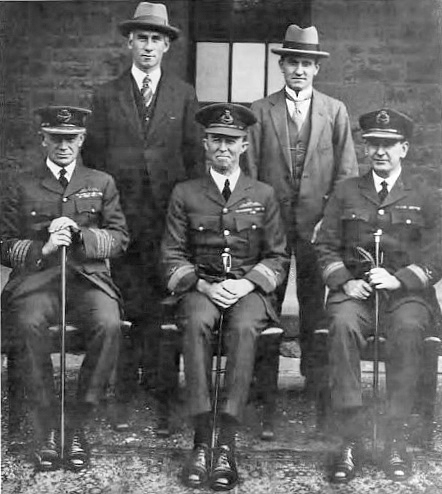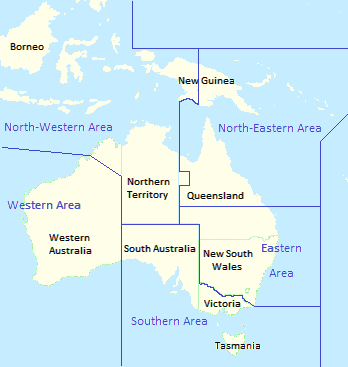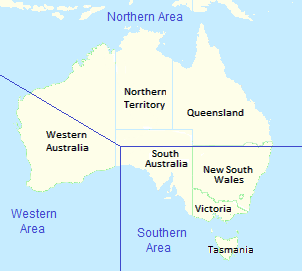|
Central Area Command (RAAF)
Central Area Command was one of several geographically based commands raised by the Royal Australian Air Force (RAAF) during World War II. It was formed in March 1940, and covered the central portion of New South Wales. Headquartered at Sydney, Central Area Command was responsible for air defence, aerial reconnaissance and protection of the sea lanes within its boundaries. It was disbanded in August 1941 and control of its units taken over by other RAAF formations. Proposals in 1943–44 to raise a new Central Area Command did not come to fruition. History Prior to World War II, the Royal Australian Air Force was small enough for all its elements to be directly controlled by RAAF Headquarters in Melbourne. After war broke out in September 1939, the RAAF began to implement a decentralised form of command, commensurate with expected increases in manpower and units.Stephens, ''The Royal Australian Air Force'', pp. 111–112 Its initial move in this direction was to create ... [...More Info...] [...Related Items...] OR: [Wikipedia] [Google] [Baidu] |
Riverina
The Riverina is an agricultural region of south-western New South Wales, Australia. The Riverina is distinguished from other Australian regions by the combination of flat plains, warm to hot climate and an ample supply of water for irrigation. This combination has allowed the Riverina to develop into one of the most productive and agriculturally diverse areas of Australia. Bordered on the south by the state of Victoria and on the east by the Great Dividing Range, the Riverina covers those areas of New South Wales in the Murray and Murrumbidgee drainage zones to their confluence in the west. Home to Aboriginal groups including the Wiradjuri people for over 40,000 years, the Riverina was colonised by Europeans in the mid-19th century as a pastoral region providing beef and wool to markets in Australia and beyond. In the 20th century, the development of major irrigation areas in the Murray and Murrumbidgee valleys has led to the introduction of crops such as rice and wine grap ... [...More Info...] [...Related Items...] OR: [Wikipedia] [Google] [Baidu] |
Australian War Memorial
The Australian War Memorial is Australia's national memorial to the members of its armed forces and supporting organisations who have died or participated in wars involving the Commonwealth of Australia and some conflicts involving personnel from the Australian colonies prior to Federation. Opened in 1941, the memorial includes an extensive national military museum. The memorial is located in Australia's capital, Canberra, in the suburb of . The Australian War Memorial forms the north terminus of the city's ceremonial land axis, which stretches from Parliament House on Capital Hill along a line passing through the summit of the cone-shaped Mount Ainslie to the northeast. No continuous roadway links the two points, but there is a clear line of sight from the front balcony of Parliament House to the war memorial, and from the front steps of the war memorial back to Parliament House. The Australian War Memorial consists of three parts: the Commemorative Area (shrine) i ... [...More Info...] [...Related Items...] OR: [Wikipedia] [Google] [Baidu] |
Air Board (Australia)
The Air Board, also known as the Administrative Air Board, or the Air Board of Administration, was the controlling body of the Royal Australian Air Force (RAAF) from 1921 to 1976. It was composed of senior RAAF officers as well as some civilian members, and chaired by the Chief of the Air Staff (CAS). The CAS was the operational head of the Air Force, and the other board members were responsible for specific areas of the service such as personnel, supply, engineering, and finance. Initially based in Melbourne, the board relocated to Canberra in 1961. Formed in 1920, the Air Board's first task was to establish the air force that it was to administer; this took place in March 1921. The board was initially controlled by an Air Council, which included the chiefs of the Army and Navy; after the council's dissolution in 1929 the Air Board had equal status with the other service boards, reporting directly to the Minister for Defence. According to Air Force Regulations, the Air Board w ... [...More Info...] [...Related Items...] OR: [Wikipedia] [Google] [Baidu] |
Eastern Area Command (RAAF)
Eastern Area Command was one of several geographically based commands raised by the Royal Australian Air Force (RAAF) during . It was formed in May 1942, and controlled units located in New South Wales and southern Queensland. Headquartered in Sydney, Eastern Area Command's responsibilities included air defence, aerial reconnaissance and protection of the sea lanes within its boundaries. Its flying units operated fighters, reconnaissance bombers, and dive bombers, and concentrated on convoy escort, maritime patrol and anti-submarine warfare. The size of the area was such that the RAAF twice considered splitting it, but nothing came of this. The area command continued to function after the war, its headquarters transferring from Sydney to Glenbrook, in the Blue Mountains, in 1949. By this time most of the RAAF's operational units—including fighter, bomber, and transport wings—were based within Eastern Area's boundaries, and the officer in command was responsible for air ... [...More Info...] [...Related Items...] OR: [Wikipedia] [Google] [Baidu] |
North-Western Area Command (RAAF)
North-Western Area Command was one of several geographically based commands raised by the Royal Australian Air Force (RAAF) during World War II. Its wartime sphere of operations included the Northern Territory, adjacent portions of Queensland and Western Australia, and the Dutch East Indies. The command was formed in January 1942, following the outbreak of the Pacific War, from the western part of Northern Area Command, which had covered all of northern Australia and Papua. Headquartered at Darwin, North-Western Area Command was initially responsible for air defence, aerial reconnaissance and protection of the sea lanes within its boundaries. In the official history of the RAAF in the Pacific theatre, George Odgers described the North-Western Area Campaign as "almost entirely an air war, with raid and counter-raid". From 1943, North-Western Area Command's role became increasingly offensive in nature, as the Allies began to advance in New Guinea and the Dutch East Indie ... [...More Info...] [...Related Items...] OR: [Wikipedia] [Google] [Baidu] |
North-Eastern Area Command (RAAF)
North-Eastern Area Command was one of several RAAF area commands, geographically based commands raised by the Royal Australian Air Force (RAAF) during World War II. For most of its existence it controlled units based in central and northern Queensland as well as Papua New Guinea. It was formed in January 1942 from the eastern part of the former Northern Area Command (RAAF), Northern Area Command, which had covered all of northern Australia and Territory of Papua, Papua. Headquartered at Townsville, Queensland, North-Eastern Area Command's responsibilities included Anti-aircraft warfare, air defence, aerial reconnaissance and protection of the sea lanes within its territory. Its flying units, equipped with fighters, reconnaissance bombers, dive bombers and transports, took part in the Battle of Rabaul (1942), battles of Rabaul, Battle of Port Moresby, Port Moresby and Battle of Milne Bay, Milne Bay in 1942, and the Battle of Hollandia, landings at Hollandia and Landing at Aitape, ... [...More Info...] [...Related Items...] OR: [Wikipedia] [Google] [Baidu] |
Pacific War
The Pacific War, sometimes called the Asia–Pacific War, was the theater of World War II that was fought in Asia, the Pacific Ocean, the Indian Ocean, and Oceania. It was geographically the largest theater of the war, including the vast Pacific Ocean theater, the South West Pacific theater, the Second Sino-Japanese War, and the Soviet–Japanese War. The Second Sino-Japanese War between the Empire of Japan and the Republic of China had been in progress since 7 July 1937, with hostilities dating back as far as 19 September 1931 with the Japanese invasion of Manchuria. However, it is more widely accepted that the Pacific War itself began on 7 December (8 December Japanese time) 1941, when the Japanese simultaneously invaded Thailand, attacked the British colonies of Malaya, Singapore, and Hong Kong as well as the United States military and naval bases in Hawaii, Wake Island, Guam, and the Philippines. The Pacific War saw the Allies pitted against Japan, the latter ai ... [...More Info...] [...Related Items...] OR: [Wikipedia] [Google] [Baidu] |
Australia In The War Of 1939–1945
''Australia in the War of 1939–1945'' is a 22-volume official history series covering Australian involvement in the Second World War. The series was published by the Australian War Memorial between 1952 and 1977, most of the volumes being edited by Gavin Long, who also wrote three volumes and the summary volume ''The Six Year War''. In contrast to the ''Official History of Australia in the War of 1914–1918'', the series has a greater focus on the war's impact upon domestic events, including volumes on operations of the Australian Government and contributions made by Australian industry and science. ''Australia in the War of 1939–1945'' includes a series on the history of the Australian military medical services and the problems encountered by these services during the war. Preparations In April 1943 the Australian War Cabinet decided that an official history of Australia's involvement in World War II should be written. Gavin Long was appointed general editor of the pro ... [...More Info...] [...Related Items...] OR: [Wikipedia] [Google] [Baidu] |
The Sun (Sydney)
''The Sun'' was an Australian afternoon tabloid newspaper, first published under that name in 1910. History ''The Sunday Sun'' was first published on 5 April 1903. In 1910 Hugh Denison founded Sun Newspaper Ltd and took over publication of the old and ailing and ''Australian Star'' and its sister ''Sunday Sun'', appointing Monty Grover as editor-in-chief. The ''Star'' became ''The Sun'', and the ''Sunday Sun'' became ''The Sun: Sunday edition'' on 11 December 1910. According to its claim, below the masthead of that issue, it had a "circulation larger than that of any other Sunday paper in Australia". Denison sold the business in 1925. In 1953, The Sun was acquired from Associated Newspapers by Fairfax Holdings in Sydney, Australia, as the afternoon companion to ''The Sydney Morning Herald''. At the same time, the former Sunday edition, the ''Sunday Sun'', was discontinued and merged with the ''Sunday Herald'' into the tabloid '' Sun-Herald''. Publication of ''The Sun'' ... [...More Info...] [...Related Items...] OR: [Wikipedia] [Google] [Baidu] |
Point Piper
Point Piper is a small, harbourside eastern suburb of Sydney, in the state of New South Wales, Australia, east of the Sydney CBD, in the local government area known as the Municipality of Woollahra. Point Piper has been historically regarded as Australia's most expensive suburb. In 2011, Wolseley Road was ranked as the ninth-most expensive street in the world, at $38,900 per square metre. Location The suburb of Point Piper sits on Sydney Harbour, beside the suburbs of Rose Bay, Bellevue Hill and Double Bay. The streets in Point Piper are: Buckhurst Avenue, Longworth Avenue, New South Head Road, Redvers Street, Saint Mervyn's Avenue, Wolseley Road, Wolseley Crescent, Wingadal Place, Wentworth Place, Wentworth Street, Wunulla Road, and Wyuna Road. Heritage listings Point Piper has a number of heritage-listed sites, including: * 10 Dunara Gardens: ''Dunara'' Commercial area Point Piper does not have a commercial area, and has few amenities or public facilities. The c ... [...More Info...] [...Related Items...] OR: [Wikipedia] [Google] [Baidu] |









